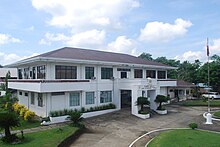Contents
San Enrique, officially the Municipality of San Enrique (Hiligaynon: Banwa sang San Enrique, Tagalog: Bayan ng San Enrique), is a 3rd class municipality in the province of Iloilo, Philippines. According to the 2020 census, it has a population of 36,911 people.[3]
Geography
Barangays
San Enrique is politically subdivdied into 28 barangays. Each barangay consists of puroks and some have sitios.
- Abaca
- Asisig
- Bantayan
- Braulan
- Cabugao Nuevo
- Cabugao Viejo
- Camiri
- Compo
- Catan-Agan
- Cubay
- Dacal
- Dumiles
- Garita
- Gines Nuevo
- Imbang Pequeño
- Imbesad-an
- Iprog
- Lip-ac
- Madarag
- Mapili
- Paga
- Palje
- Poblacion Ilawod
- Poblacion Ilaya
- Quinolpan
- Rumagayray
- San Antonio
- Tambunac
Climate
| Climate data for San Enrique, Iloilo | |||||||||||||
|---|---|---|---|---|---|---|---|---|---|---|---|---|---|
| Month | Jan | Feb | Mar | Apr | May | Jun | Jul | Aug | Sep | Oct | Nov | Dec | Year |
| Mean daily maximum °C (°F) | 28 (82) |
29 (84) |
30 (86) |
32 (90) |
32 (90) |
30 (86) |
29 (84) |
29 (84) |
29 (84) |
29 (84) |
29 (84) |
28 (82) |
30 (85) |
| Mean daily minimum °C (°F) | 23 (73) |
22 (72) |
23 (73) |
23 (73) |
25 (77) |
25 (77) |
24 (75) |
24 (75) |
24 (75) |
24 (75) |
24 (75) |
23 (73) |
24 (74) |
| Average precipitation mm (inches) | 57 (2.2) |
37 (1.5) |
41 (1.6) |
42 (1.7) |
98 (3.9) |
155 (6.1) |
187 (7.4) |
162 (6.4) |
179 (7.0) |
188 (7.4) |
114 (4.5) |
78 (3.1) |
1,338 (52.8) |
| Average rainy days | 12.0 | 7.7 | 9.2 | 10.2 | 19.5 | 24.6 | 26.9 | 25.1 | 25.5 | 25.2 | 18.0 | 13.0 | 216.9 |
| Source: Meteoblue[5] | |||||||||||||
Demographics

| Year | Pop. | ±% p.a. |
|---|---|---|
| 1903 | 2,596 | — |
| 1960 | 11,109 | +2.58% |
| 1970 | 13,104 | +1.66% |
| 1975 | 17,270 | +5.69% |
| 1980 | 19,663 | +2.63% |
| 1990 | 24,730 | +2.32% |
| 1995 | 25,576 | +0.63% |
| 2000 | 28,655 | +2.47% |
| 2007 | 30,006 | +0.64% |
| 2010 | 32,422 | +2.86% |
| 2015 | 33,911 | +0.86% |
| 2020 | 36,911 | +1.68% |
| Source: Philippine Statistics Authority[6][7][8][9] | ||
In the 2020 census, the population of San Enrique, Iloilo, was 36,911 people,[3] with a density of 330 inhabitants per square kilometre or 850 inhabitants per square mile.
In the 1995 National Census, it had a registered total household population of 25,572, an increase of 875 over the 1990 total population of 24,697.
Aside from the prevailing inhabitants of this municipality, the transient ethnic groups that frequent this place belongs to the cultural minority, the Aetas or Negriteos. They are seasonally around during the planting and harvesting of sugarcane.
References
- ^ Municipality of San Enrique | (DILG)
- ^ "2015 Census of Population, Report No. 3 – Population, Land Area, and Population Density" (PDF). Philippine Statistics Authority. Quezon City, Philippines. August 2016. ISSN 0117-1453. Archived (PDF) from the original on May 25, 2021. Retrieved July 16, 2021.
- ^ a b c Census of Population (2020). "Region VI (Western Visayas)". Total Population by Province, City, Municipality and Barangay. Philippine Statistics Authority. Retrieved 8 July 2021.
- ^ "PSA Releases the 2018 Municipal and City Level Poverty Estimates". Philippine Statistics Authority. 15 December 2021. Retrieved 22 January 2022.
- ^ "San Enrique: Average Temperatures and Rainfall". Meteoblue. Retrieved 3 May 2020.
- ^ Census of Population (2015). "Region VI (Western Visayas)". Total Population by Province, City, Municipality and Barangay. Philippine Statistics Authority. Retrieved 20 June 2016.
- ^ Census of Population and Housing (2010). "Region VI (Western Visayas)" (PDF). Total Population by Province, City, Municipality and Barangay. National Statistics Office. Retrieved 29 June 2016.
- ^ Censuses of Population (1903–2007). "Region VI (Western Visayas)". Table 1. Population Enumerated in Various Censuses by Province/Highly Urbanized City: 1903 to 2007. National Statistics Office.
{{cite encyclopedia}}: CS1 maint: numeric names: authors list (link) - ^ "Province of Iloilo". Municipality Population Data. Local Water Utilities Administration Research Division. Retrieved 17 December 2016.
External links
- Philippine Standard Geographic Code
- Philippine Census Information
- Local Governance Performance Management System

